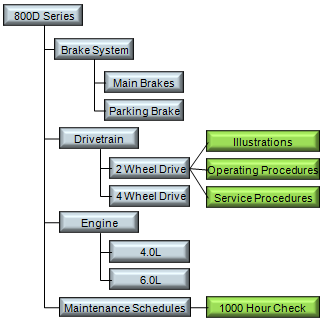About Information Structures
An information structure is a product-centric hierarchical structure that organizes information related to a product or library. Information structures are implemented as a type of part structure within Windchill.
Within an information structure, information subgroups called information groups organize content. These content objects are called information elements. There are several supported kinds of information elements: dynamic documents, graphic dynamic documents, documents, and parts lists.
Information structures can be many levels deep (major systems, sub-systems, components). You can expand the hierarchy to display the lower levels to reveal more detail.
Filtering criteria provides the ability to identify and manage information associated with product variations. Information structures can be filtered to show optional components or parts with specific attribute values. Objects are displayed in the structure according to the currently active structure filter. Filters can be edited, and the structure refreshed, to show the objects that meet the new filter criteria.
Information structures can be compared to determine the impact of product changes. The information structure that is currently in production can be compared to a new information structure under development to reveal the impact of the proposed changes. Relationships to supporting product information can help to determine the quantity and scope of the work to be done.
A product or library can support multiple information structures, and each information structure can support nested information structures. Each product or library has a designated primary information structure, which you can specify or change. See
Set as Primary Information Structure.
An information structure can contain an indented hierarchy of other objects. Each entry in the structure is identified by an icon and name. An information structure can contain the following types of objects:
• Other information structures
• Information groups
• Information elements (graphic, textual, and parts list)
An information element is reusable content in a Windchill Service Information Manager structure. You can reuse these components at various levels within and across products and libraries. For example, repair procedures for an engine can be reused by all the products or libraries which use that engine.
You can display the information structures associated with the library or product:
1. In the Navigator, select the Browse tab.
2. Select a product or library and expand it.
3. Do either of the following:
◦ Select the Details folder and choose the Details tab to display the Information Structures table. The Information Structures table lists the information structures for the product or library.
◦ Select the Information Structure folder to display the primary Information Structure for the product or library.
4. Click the view information icon

for the information structure to display its information page.
For more information on the information structure table, see
The Service Structures Tables.
The
Structure tab on the
Service Structure Information Page provides tools that enable you to develop a hierarchy of objects. On the
Structure tab of the information page, objects can be expanded one level at a time using the expansion arrows to the left of each object, or you can specify the levels using the
 Display
Display menu within the
Viewing action set or the shortcut menu. Columns can be added using > .
You can reorder items in an information structure. For more information, see
Rearranging Service Structure Objects.
You can enter an object name in the Find in Structure field just above the structure pane to locate a specific object if using expansion is impractical for a large structure. You can also enter a number if the view displays the Number column.
Publishing an Information Structure
An information structure can be published for
Servigistics InService or other delivery applications as XML bundles. For more information, see
Publishing a Bundle from an Information Structure.


